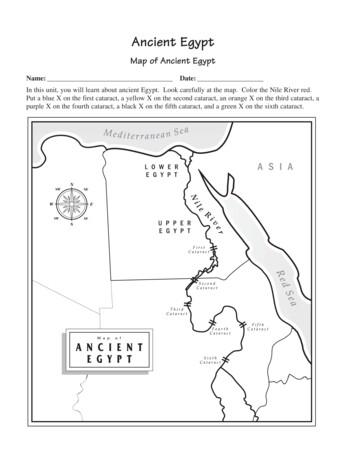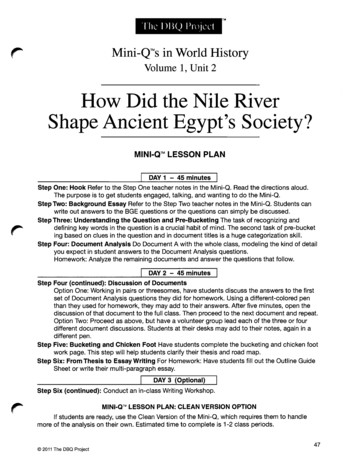Ancient Egypt - Mr. Brown's Webpage
Ancient Egypt
Beginnings of Ancient Egypt6,000 B.C.--The firstinhabitants begin tosettle around the NileRiver.3,100 B.C.--The King ofUpper Egypt namedMenes, united Upperand Lower Egypt.Menes makes the city ofMemphis his capital city.
Egypt’s Pharaohs ruled as Gods!Pharaohs were Gods. (Different fromMesopotamia civilizations Kings wererepresentatives of the gods).Pharaohs were the center of Egypt’sreligion, government, and army.
HieroglyphicsA form of Egyptian writing based on pictorialcharacters for words and sounds.Sacred writing connected to Egyptianreligion
Rosetta StoneThe Rosetta Stonecarries an inscription indifferent languageswhich helped decipherthe ancient Egyptianhieroglyphic script.It is the only survivingfragment of a largerstone slab recording adecree on 27 March,196 BC.
Social Classes in Ancient EgyptNew Kingdom: slaves
Menes & The Old KingdomMembers of Menes’sfamily passed thedouble crown of upperand lower Egypt fromfather to son tograndson.A series of rulersfrom a single familyis called a dynasty.Ancient Egypt wouldconsist of 31dynasties, spanning2,800 years.
Immortality of the PharaohEgyptians believed that their pharaoh ruledeven after his death. He had an eternalspirit, or ka, that continued to take part in thegoverning of Egypt.Egyptians also believed that the karemained much like a living pharaoh in itsneeds and pleasures.
Immortality of the PharaohPharaoh’s Tomb needed the following:Eternal comforts: Artists decorated the wallsof the burial chamber with pictures ofwhatever he might need or like. (Endlessmeals, loved ones, devoted servants, etc.)Luxuries: Fine jewelry, game boards withprecious stones, rich clothing.Inscriptions: Writings of what the pharaohachieved in life were also found on the tombwalls.
The Old Kingdom & PyramidsThe Old Kingdom was the great age ofpyramid building in ancient Egypt.The pharaohs expected to reign forever.Their tombs (pyramids) were more importantthan their palaces.
Pyramids at GizaBlocks from the pyramids weigh at least 2 ½ tons. Someweigh up to 15 tons.Peasantsworked on thePyramids inorder to be fedduring the floodseason.About 80pyramids stillstand in theEgyptiandesert.
Pyramids at Giza
First Intermediate Period:Sea PeoplesThe Old Kingdom comes to an end.Power of the pharaohs declined.5th – 6th dynasties weak centralgovernmentMore and more power fell to the noblesand officials.Local rulers struggled among themselvesfor power.Civil WarInvasion by the Sea Peoples.
Royal Power Returns in theMiddle Kingdom (2080-1640 B.C.)Law & Order returned to Egypt under somestrong kings.Farming revived, trade grew, and the artsflourished.The capital moved from Memphis to Thebes.Public projects were created by the great tradebrought in.
Royal Power Returns in theMiddle Kingdom (2080-1640 B.C.)Time of turbulenceAfterlife for pharaoh, royal family, powerfulnoble families:During the Old Kingdom, only the pharaohshad expected to live forever. During theMiddle Kingdom, an afterlife extended to thenobility.l
Second Intermediate PeriodCivil War between royal family and powerfulnoble families broke out again.Egypt became prey to outside invaders.Egyptians were ruled by Hyksos (AsianNomads).They ruled from 1640-1570 B.C.Egyptians despised the less civilizedHyksos.
Hyksos Bring New Skills to the EgyptiansAbility to make bronze toolsand weapons vs copperAbility to wage war from horsedrawn chariots.Shooting arrows from apowerful new kind of bow.Spinning and weavingtechniques.
The New Kingdom:An Age of Empires (1570-1075 B.C.)This kingdom was morepowerful and wealthier thanever before.Egyptians becameconquerors.Professional army included:bowmen, charioteers, andinfantry.King Tutankhamon ruledduring this time period.
Above: Nov. 4, 2007: King Tut'smummy, unmasked and on publicdisplay in Egypt for the first time sincebeing discovered 85 years ago.Right: A facial-reconstruction modelof King Tutankhamun made by aFrench team based on CT scans ofthe boy king's mummy.
Right: One of the twomummified fetusesfound in the tomb ofKing Tutankhamun in1922 during modernpreparations for a DNAtest in Cairo, Egypt.
Rule By QueenQueen Hatshepsut declaredherself pharaoh around1478 B.C. (Her stepsonwas too young to rule).She ruled for 22 years.She was better knownfor encouraging tradethan waging war.
Queen HatshepsutAbove: Archaeologists today used a missing tooth topositively identify the mummy of Hatshepsut, Egypt'sgreatest woman pharaoh who reigned more than 3,000years ago.
The Temple at Deir-El-BahriHatshepsut wasan 18th-dynastypharaoh whowas one of ahandful offemale rulers inAncient Egypt.
The Temple at Deir-El-BahriHer reign wasthe longest of allthe femalepharaohs, andher funerarytemple stillstands as atribute to herincredible rise topower.
The Temple at Deir-El-Bahri
Queen HatshepsutCarved scenes on her great funeral temple showher officials on a trade expedition to the eastAfrican coast, buying myrrh, frankincense, ebony,ivory, and leopard skins.No one knows whether Hatshepsut died naturallyor was murdered by her stepson (Thutmose III).
A Warrior PharaohThutmose III proved to be amore warlike ruler than hisstepmother.From 1450 - 1425 B.C., heconducted 15 victoriousinvasions into Palestine andSyria. His armies alsopushed south as far as Nubiaand returned with thousandsof slaves.
Images of Thutmose III
Meeting Their Match: HittitesBy 1300 B.C. – Egyptianscame face to face with theHittites.Their armies met atKadesh in 1288 B.C.They fought each otherto a stand still.
Meeting Their Match: HittitesThe pharaoh and Hittiteking made a treaty,promising “peace andbrotherhood between usforever.”For the rest of thecentury the twokingdoms were allies.
An Age of BuildersThe Old Kingdom builders built pyramids for their pharaoh’stombs. The pyramids were too expensive, visible and easilyrobbed.Rulers of the NewKingdom built theirtombs beneath desertcliffs.Valley of theKings nearThebes.KingTutankhamonundisturbed tomb
Tutankhamen's tomb (lower left) in the Valley of theKings in western Thebes, Egypt.
Ramses IIOne of the greatest rulers of the New Kingdom wasRamses II.Ramses II reigned for 67 years (1279-1212 B.C.).He lived to the age of 99 and was the father of150 children.Ramses created the giant temple of Amon(Egyptian’s chief god) at Karnak.The buildings were huge and impressive, butthey are not as skillfully built as those of the OldKingdom.
Rameses II ("the Great") may be the most famous of allEgyptian kings. He reigned for 67 years and lived wellinto his 80s. By the time of his death, he suffered fromsevere arthritis, arteriosclerosis, and abscesses in histeeth.
Temple of Amon at Karnak
Egypt’s Power Declined1200 B.C.– Invasions destroyed many kingdoms.Egyptian records speak of attacks by “ThePeople of the Sea.” Little is known of theseinvaders, but the destruction they left behindwas vast.Both the Egyptian and Hittite kingdoms fell tothese mysterious enemies.In 671 B.C. Assyrians took over Egypt. A centuryand a half later it was the Persians turn to conquerEgypt.
Beginnings of Ancient Egypt 6,000 B.C.--The first inhabitants begin to settle around the Nile River. 3,100 B.C.--The King of Upper Egypt named Menes, united Upper and Lower Egypt
8002 Signal Brown 8003 Clay Brown 8004 Copper Brown 8007 Fawn Brown 8008 Olive Brown 8011 Nut Brown 8012 Red Brown 8014 Sepia Brown 8015 Chestnut Brown 8016 Mahogany Brown 8017 Chocolate Brown 8019 Grey Brown 8022 Black Brown 8023 Orange Brown 8024 Beige Brown 8025 Pale Brown. 8028 Earth Brown 9001 Cream 9002 Grey White 9003 Signal White
Ahmed Abdel Ahad Donia Egypt Samer Moustafa Mohamed El Sayed Egypt Ahmed Mohammed Ibrahim Obaid Egypt Yasser Elsaadawy Egypt Ahmed Salah Behiry Dr. Egypt Zakaria Ahmed Rashad Mohamed Eqypt Amira Salah Hassan Said Egypt Aleykutty Shaji India Ayman Ibrahim Alnwehi Egypt Annamma Anandamadam Othman India
This is the third paper in a series of research papers exploring the history of mechanical engineering during the Ancient Egypt era. The industry of necklaces in Ancient Egypt is investigated over seven periods of Ancient Egypt History from Predynastic to Late Period. The paper presents samples of necklaces from the seven periods and tries to .
Egypt was a grassland. Nomads traveled in search of food King Menes united Upper & Lower Egypt. Established capital at Memphis. Age of Pyramids. First man made mummies Romans take control of Egypt. Egypt never rises to greatness again. Alexander the Great conquers Egypt. Cleopatra is the last Phar
The first pharaoh of Egypt was Narmer, who united Lower Egypt and Upper Egypt. Egypt was once divided into two kingdoms. The kingdom in Lower Egypt was called the red crown and the one in Upper Egypt was known as the white crown. Around 3100 B.C. Narmer, the pharaoh of the north, conquered the south a
Around 3100 BC, there were two separate kingdoms in Egypt, Upper Egypt and Lower Egypt. Soon aerwards, King Narmer (from Upper Egypt) united the t wo kingdoms. When the unificaon happened, it became the world ’s first ever na†on -state. King Narmer was the first king of Egypt ’s
Ancient Egypt Vocabulary (cont.) 13. Nubia—ancient civilization located to the south of Egypt 14. Old Kingdom—period in ancient Egyptian history from 2686 B.C. to 2181 B.C. 15. papyrus—a plant that was used to make paper 16. pharaoh—ancient Egyptian ruler who was believed to be part god and part human 17. phonogram—a picture that stands for the sound of a letter
more true than in the ancient kingdom of Egypt. Ancient Egypt was a world of contrasts and op- posites, a place of hot, sunny days and cold nights, of crop- laden fields and empty desert. In its early time, the kingdom was actually two distinct lands called Upper Egypt (the higher the delta. Irrigation channels from the Nile flowed to smaller























